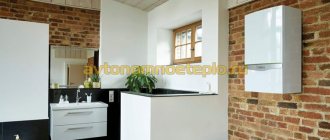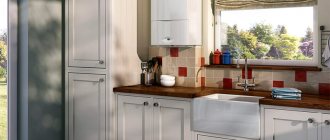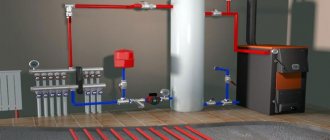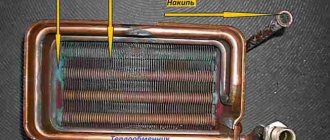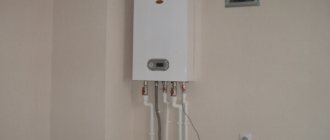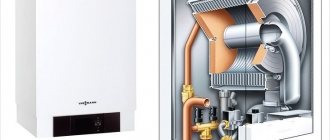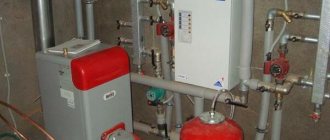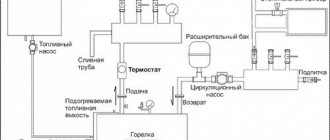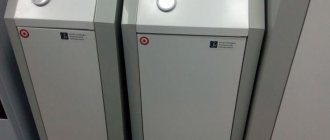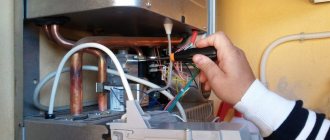Material for installing a wall-mounted gas boiler
Installation of a wall-mounted gas boiler begins in the store. Of course, this is not the installation itself, but preparation for it. When purchasing or ordering a wall-mounted gas boiler, you need to find out or inspect whether the boiler is equipped with fastening elements. Usually these are hooks and power dowels. If this fastener is not included with the boiler, it must be purchased.
Boiler manufacturers complete the boiler with special installation patterns, which are used to mark and drill holes for mounting the boiler.
Note: Let me remind you that when choosing a wall-mounted gas boiler and purchasing it, you must inquire and request a certificate of conformity for the selected boiler model. Without this certificate, legalization (obtaining permission to connect) will be very problematic.
Features of boiler installation depending on the type of combustion chamber
The requirements for the room in which the wall-mounted gas boiler is located depend on the type of combustion chamber: open or closed.
…
An open combustion chamber uses air for the combustion process from the room in which the heating system is located, and exhaust gases are discharged through the chimney. Such gas boilers require a certain volume of air, otherwise the gas does not burn completely and forms toxic toxic substances. Therefore, the operation of units with an open combustion chamber is permissible only in a separate room, which is called a boiler room or furnace room. It is necessary to provide a window for ventilation with an area of at least 0.5 m². The walls of the boiler room must be finished with fire-resistant materials.
The volume of the combustion chamber depends on the power of the gas boiler:
- if it does not exceed 30 kW, then a room with a volume of 8 m³ is sufficient;
- for a boiler with a capacity of 30-60 kW, a boiler room with a volume of 13-14 m³ is required;
- for units with a power of up to 200 kW – from 15 m³.
The connection between the boiler and a conventional chimney is made by using an iron pipe of a certain cross-section. It must be resistant to high temperatures and toxic combustion products. When installing a connecting pipe, the following rules must be followed:
- the length of its vertical part when exiting the boiler before turning must be at least two diameters;
- Place the connection with a slight inclination towards the unit.
combustion chamber is suitable if it is not possible to install a separate combustion chamber. These boilers come with a coaxial chimney, which is quite easy to install yourself. It is a structure of two pipes, one of which is inserted into the other. With a closed type of combustion chamber, air enters from the street through an external pipe, and combustion products exit into the atmosphere through an internal pipe.
If you have chosen a gas boiler with a closed combustion chamber, keep in mind that such equipment will require an electrical connection to provide power to the fan, which creates air flow through the coaxial chimney.
…
Gas units equipped with closed combustion chambers are considered safer and more environmentally friendly, so they can be placed in the bathroom, kitchen or pantry.
Details about gas boilers with an open combustion chamber
kotel-s-otkrytoj-kameroj-sgoraniya/ Read how to arrange the chimney of a domestic gas boiler here
Tool for installing a gas wall-mounted boiler
For work you need to prepare the following tool:
- Electric drill or hammer drill. A drill is needed to drill holes for mounting a gas boiler.
- Construction level, more than 1 meter long.
The construction level plays an important role in the installation of a gas boiler, and especially a condensing gas boiler. Any tilt of the condensing gas boiler will lead to its failure in the shortest possible time. It’s a good idea to replace the building level with a laser level, this will improve the accuracy of installation.
Preparing the wall for installing a gas boiler
The room where the wall-mounted gas boiler will be located must meet a whole list of requirements for the combustion room. Often, wall-mounted gas boilers are installed in the kitchen and the space in the kitchen must be prepared for installation of the boiler.
In addition to ventilation, airing and other rules, special attention should be paid to the wall on which the boiler will be placed.
- The wall for hanging the gas boiler must be strong. The material or structure of the wall must be adapted to install the power fasteners on which the boiler will hang.
- If the wall for hanging the boiler is made of plasterboard, then in advance in the frame of the plasterboard structure, it is necessary to provide and lay firmly fixed wooden blocks in the place where the fasteners are installed.
- If the material of the wall or its finishing is potentially flammable, a non-flammable gasket of 3 mm thick and 10-15 cm larger than the dimensions of the boiler is installed between the wall and the boiler body.
- According to standards, a wall-mounted gas boiler should be 40-45 mm away from the wall. Therefore, the gas boiler is not mounted on the wall, but on bars previously fixed to the wall.
Standards for installing gas mounted boilers
There are regulations that specify construction rules for installation.
When installing, be sure to follow the standards. Photo source: strmnt.com
First you will have to fulfill all the conditions specified in these documents:
- Call the gas workers so that the specialists check the existing conditions and, if the rules are followed, allow the connection of the unit to the central main line of the house.
- Draw up the project correctly to avoid a fine. An exception is that the heat generator has already been installed in the house and you only need to replace it with an identical model.
As soon as the project is completed, it is necessary to contact the state supervision authorities with papers. After checking, they issue permission to install a wall-mounted boiler.
Then you need to fulfill a few more mandatory conditions - choose the right height and comply with the requirements. security.
Height
When installing the boiler on the wall, you must follow the rules for selecting the optimal height specified in the SP. It says that from the floor to the bottom of the purchased boiler the distance should be 0.9 meters (minimum), but not more than 1.2 meters. It is important to note that these parameters are used for boilers, but gas manufacturers often impose these requirements on boilers as well.
It is important to comply with the minimum height established by gas workers, which is calculated by the distance from the chimney pipe. Official regulations indicate that a wall-mounted device will have to be lowered by 2 diameters (minimum value) of the chimney.
The permissible limits for installing a heat generator are 0.8-1.8 from ground level.
Fire safety standards for installation
Equipped boiler room. Photo source: th360.ru
When installing a wall-mounted gas boiler in an apartment, it is necessary to comply with safety standards.
Therefore, it is necessary to set fire breaks (minimum indicators that should be adhered to are indicated):
- The distance from the equipment to the wall is at least 10 cm.
- From the opposite wall - at least 40 cm.
The fire safety rules clearly state that a thermal insulation shield must be installed on the equipment, attaching it to the wall. It must be located immediately under the gas boiler. If you have to install a chimney through the roof, then it is also necessary to install fire breaks.
It is necessary to install a protective non-combustible partition between the room with a single-circuit wall-mounted boiler and the residential part. It must have an increased degree of fire resistance for the safety of household members. When connecting equipment, it is necessary to use a corrugated metal pipe. It is strictly forbidden to purchase rubber hoses for boiler installation.
Hanging a gas boiler on the wall
- Mark the installation level of the gas boiler. Height from the floor from 800 to 1600 mm.
- Attach a non-flammable material (asbestos) and a piece of metal sheet (galvanized sheet) to a wooden wall.
- Other types of walls, for aesthetic installation of the boiler, should be covered with ceramic tiles.
- If the boiler is not equipped with a special bracket, install bars at the level of the gas boiler mounting to ensure that the boiler is indented from the wall.
- Mark the mounting locations for the gas boiler. Usually, the packaging or instructions contain the exact dimensions of the boiler mounting points or an installation template. It is important to maintain the exact horizontal level of the gas boiler.
Important! A condensing gas boiler should hang with a slight slope, “away from you”, that is, the distance from the boiler to the wall at the top should be less than the distance to the wall at the bottom.
Important to remember! Whatever material the heating system in the house (apartment) is made of, the boiler is connected only with metal pipes.
Installation on different walls
Boilers are quite heavy, and therefore problems can arise if you do not take into account the reliability of fixation to the wall. There are certain standards for installing boilers, which indicate that installation work must be carried out only on a rigid wall.
Requirements may vary greatly depending on the material that was used to build the walls in the house. There are standards for wooden, reinforced concrete, plasterboard and brick surfaces.
Installation on a reinforced concrete wall
Reinforced concrete walls are the most suitable option for installing a wall-mounted gas boiler. They have increased strength and are completely non-flammable. Therefore, there was no need to use additional methods of protection in the form of cladding. To fix the heat generator body, metal anchors are used, onto which the mounting plate is fixed. After this, the unit is installed on the prepared site. Any type of heating system can be installed on concrete walls: those with high power or a conventional storage-type broiler.
Installation on a brick wall
The installation standards separately stipulate the conditions for fastening to a brick wall. Brick is another high-quality non-combustible material, and therefore the equipment is installed directly on the wall, but this time you will have to prepare the surface.
Photo source: obustroeno.com
In order not to violate the requirements of gas workers, the wall must be plastered before installation work. During this work, you will need to install a special strip. After finishing the plastering, two bolts should protrude from the wall, which serve as a seat for the equipment.
Is it possible to hang a boiler on a wooden wall?
Installing a wall-mounted gas boiler in a wooden house is a difficult task due to a number of nuances. A wooden wall can catch fire, so you need to take safety precautions.
To properly install a heating boiler, you will have to fulfill several special conditions:
- Carefully treat the wood at the installation site. It’s quite easy to do this with your own hands - there are special fire retardants in hardware stores. They will need to treat the wall generously.
- The wall must first be covered with plaster (thickness – 15 mm). This is the minimum value that guarantees protection against high temperatures. You can also line the wall with roofing steel.
If you do not want to use plaster or metal cladding, you can put a gypsum fiber board in the place where the heat generator is mounted, and then cover it with ceramic tiles.
To prevent a heavy heating boiler from falling from its installed place, it is necessary to strengthen the platform with a powerful beam, which is placed under the facing material. Thus, it will be possible to securely fix the heat generator on the wall.
Can it be hung on drywall?
When installing drywall, voids cannot be avoided. This creates problems with fastening a heavy heat generator. However, there is an option to eliminate this shortcoming.
Boiler on a plasterboard wall. Photo source: primtara.ru
When the metal frame is being manufactured, it is necessary to select in advance a place to fix the boiler and carry out preparatory work. It is necessary to reliably strengthen the site using wooden beams and metal profiles. For installation on fragile drywall, special fasteners are used. These are plastic plugs that are screwed into the facing material. The hardware must be mounted into the already installed plug. Experts say that ready-made fasteners gradually become loose, which leads to deterioration of fixation.
Mounting the boiler on foam concrete and aerated concrete
If the house is built of aerated concrete or foam concrete, then several methods can be used to install the boiler:
- The fastenings are installed in advance at the moment when the blocks are laid. The boiler is installed when the masonry mixture has completely hardened.
- In stores you can find screws for fixing in foam concrete. They are very similar to the cork used for drywall. But they have a deeper thread and a larger pitch. As soon as the material is screwed into foam concrete or aerated concrete, any anchor can be installed in the screws that will reliably hold gas equipment.
- Another reliable method of fixation is with studs. They are installed with a small gap from each other, and a strip is mounted into the wall (on each side), which is firmly fixed with bolts for maximum reliability.
- You can also use liquid, chemical anchors. They provide a strong hold, but are more expensive than previous options.
Preparing a gas boiler for hanging
In front of the gas boiler canopy:
- The boiler is removed from the package;
- The marking plate on the boiler body is checked against the certificate and invoices;
- The bracket included in the boiler kit or other selected fasteners is screwed to the installation location on the wall;
- All factory plugs on the boiler are removed;
- The internal pipe system MUST be washed.
- The gas boiler is hung in place.
After hanging, the horizontal position of the boiler is checked and adjustments are made if necessary. All! Hanging, or rather, installation of the wall-mounted gas boiler is complete. The next step is connecting the gas boiler to the system.
Is it possible to install the equipment yourself?
Installing a wall-mounted gas boiler is not the easiest task. The safety of the residents of the house directly depends on the correctness and quality of the settings. Therefore, the requirements for the installation of a gas heat generator are regulated by strict standards, in accordance with the legislative framework of Russia.
As a result, installing a wall-mounted gas boiler is a very difficult task, and often beyond the capabilities of a beginner. Special knowledge is required on how to properly install and connect the equipment so that it works properly and is safe.
